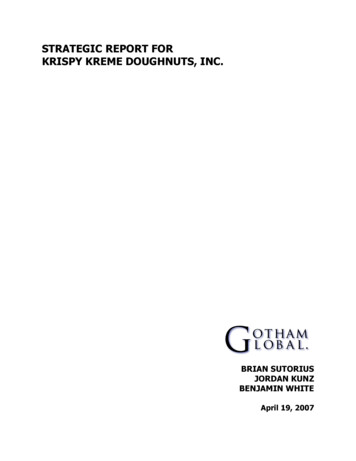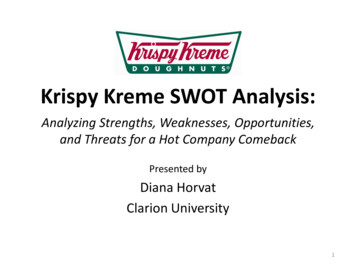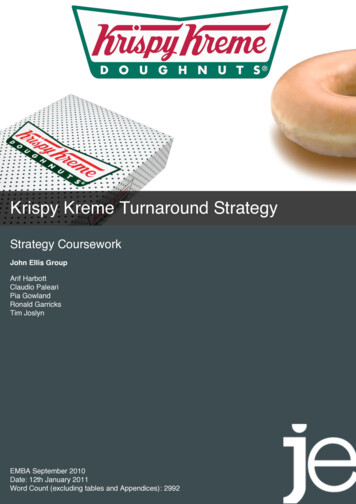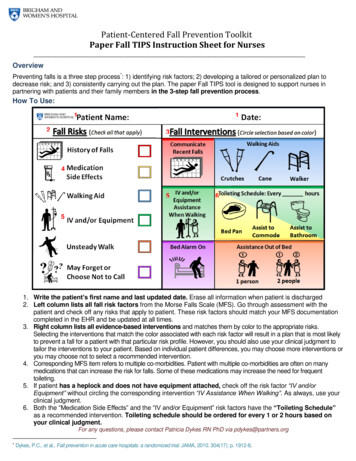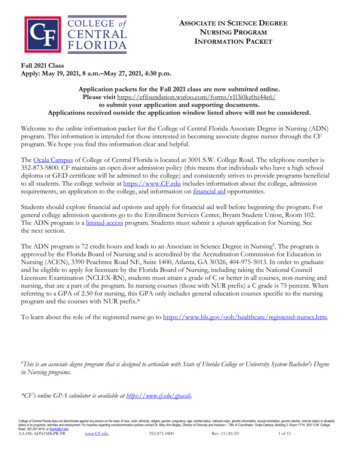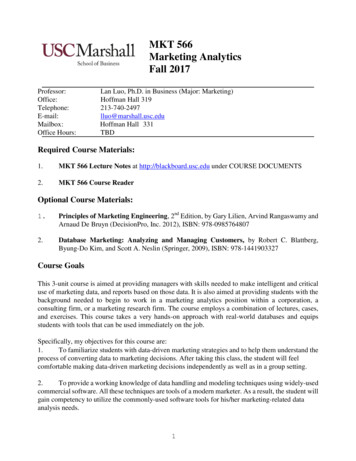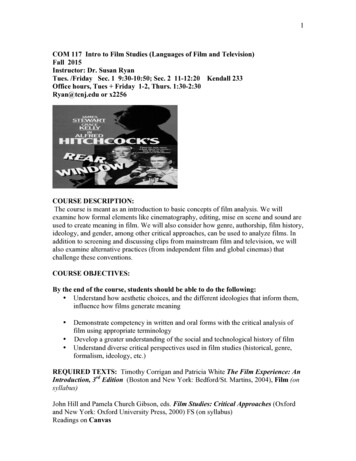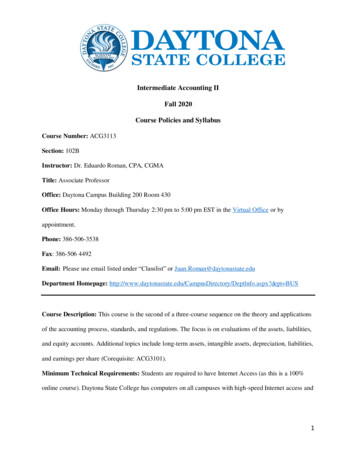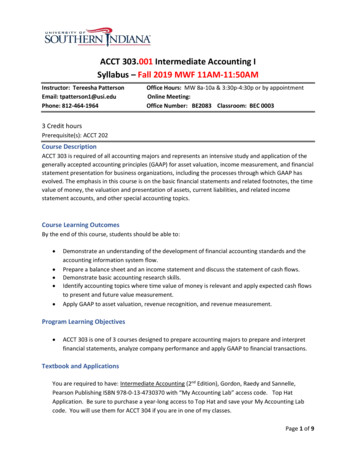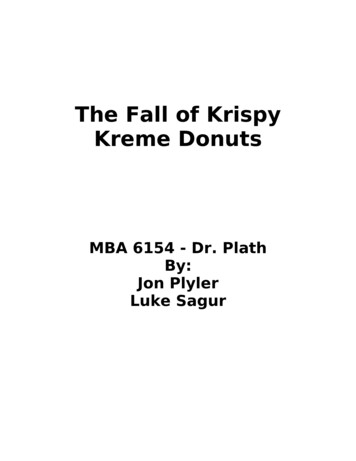
Transcription
The Fall of KrispyKreme DonutsMBA 6154 - Dr. PlathBy:Jon PlylerLuke Sagur
IntroductionSince its IPO in April 2000, Krispy Kreme grew to be a top pick of WallStreet Analysts. The company’s growth seemed unstoppable and KrispyKreme was able to beat Wall Street’s expectations. Krispy Kreme continuedto outperform until 2004 when some accounting woes were brought to lightand analysts starting noticing other anomalies that indicated that thingswere not quite as good as they seemed. The firm’s stock price quicklyplummeted from its peak and lost more than 80 percent of its value in only16 months.This case study focuses on the use of financial statement analysis, andother factors that an equity analyst would use to gauge the health of a firm,to help identify symptoms that demonstrate things where not as good asthey seemed at Krispy Kreme. The report starts by introducing KrispyKreme, their history, structure and strategy. We will then discuss KrispyKreme's financials and other tell tales that were available to predict thedemise of the firm. To wrap up the report we will conclude by summarizingall the signs that demonstrated things were amiss and answer the question:"Can financial statement analysis predict the future?"Krispy Kreme HistoryKrispy Kreme began as a small business in Winston Salem, NorthCarolina in 1937 shortly after the company’s founder, Vernon Rudolph,purchased a doughnut recipe from a French chef from New Orleans. Krispy2
Kreme was initially a doughnut wholesaler that sold its products directly tosupermarkets. Krispy Kreme doughnuts were such a hit with consumers thatRudolph decided to make them available at the factory, an idea that led towhat many people find so appealing about Krispy Kreme, the factory storeconcept. Rudolph franchised the business which helped Krispy Kreme tospread into 12 states with 29 shops by the late 1950’s.Krispy Kreme was sold to Beatrice Foods in 1973 after Rudolph’s death.Beatrice added more products to their Krispy Kreme menu, such as soupsand sandwiches and at the same time enacted cost-cutting measures bychanging store design and using cheaper ingredients in the doughnuts. Theintroduction of new products and lower quality doughnuts was not a hit withcustomers. The vision Beatrice had for Krispy Kreme was failing and thedecision was made to sell franchise.In 1982 a group of investors led by one of the original Krispy Kremefranchisees, Joseph McAleer, completed a leveraged buyout of Krispy Kremefrom Beatrice and quickly began to return it to its roots, mainly by revertingto the original doughnut recipe and signage. Six years later the companywas free of debt and beginning to expand. In the spring of 2000 KrispyKreme, amidst much fanfare and market excitement, went public with a highprofile IPO.The Krispy Kreme Model3
The heart of the Krispy Kreme concept is the factory store, or“Doughnut Theater” experience, where customers can see the doughnutsbeing made and consume one just seconds after it comes off the conveyorbelt. The “Hot Doughnuts Now” sign, when illuminated, alerts passersby tothe fact that hot doughnuts are available. The average factory store canproduce as many as 10,000 doughnuts in a day, most of which are sold offpremises to local convenient stores and grocery stores. Approximately 27percent of sales revenue are attributed to on-premises sales and 40 percentare attributed to off-premises sales. Figure 1 gives a graphical representationof Krispy Kreme's revenue streams.Figure 1Another large revenue source is the KKM&D division whichmanufactures and distributes the raw ingredients, doughnut making4
machinery, and coffee. All stores, both company owned and franchisedowned, must purchase these products from KKM&D. This allows KrispyKreme to maintain tight control on quality. The KKM&D division accounts forapproximately 27 percent of total Krispy Kreme’s revenue.Krispy Kreme is very dependent on franchisees for expansion into newmarkets. Franchisees that were in business before the IPO are considered asKrispy Kreme associates while new franchisees are considered AreaDevelopers. The associates were able to carry on with business as usual butthe Area Developers are responsible for helping to grow the business. EachArea Developers incur a one-time franchise fee of up to 50,000 then pay upto 6% of sales to Krispy Kreme as a royalty and 1% of annual sales as anadvertising fee. The franchise royalties account for approximately 4% ofKrispy Kreme’s revenue.Krispy Kreme – By The Numbers: Financial Statement AnalysisKrispy Kreme’s investors enjoyed a quick return on theirinvestment after the IPO. By the end of 2000 the stock price had doubled,then shot to a high of 4.5x the IPO price by mid-2001. Krispy Kreme was oneof the new glamour stocks on Wall Street, but from the standpoint of aneducated investor was it healthy enough to support the success of its stock?An analysis of the Krispy Kreme financials should give some insight into thehealth of the company.5
Krispy Kreme’s revenue increased every year between 2000 and 2004,from 220m to over 665m. Along with growing revenues, the operatingand net profit margins also increased every year. The operating marginincreased from just under 4% in 2000 to over 15% by the end of 2004 andthe net profit margin increased from just under 3% to over 8% during thesame time period. The ROA and ROE though the time period were relativelysteady at an average of 8.28% and 12.62% respectively. Krispy Kreme’sliquidity remained relatively constant from 2000 to 2002, but quicklyincreasing. By 2004 Krispy Kreme had quick and current ratios of 2.72x and3.25x respectively and an interest coverage ratio of 23x. From thesenumbers it did appear that Krispy Kreme was able to maintain a very liquidposition and grow rapidly without the use of much debt.As with any ratio analysis, the ratios themselves cannot give theinsight needed to fully evaluate the health of the company. To properlyevaluate the ratios of a particular company the ratios must be compared tothose if its peers. In this case Krispy Kreme’s metrics are compared toothers in the quick service restaurant sector. This comparison shows a fewinteresting anomalies. Both the quick ratio and current ratio are doublethose of the other companies’. Furthermore, the Krispy Kreme leverageratios are out of line with those of its peers; its long term debt to equity is11.26% compared to an average of 53.1% of its peer's. This fact supportswhat was seen previously, that Krispy Kreme was growing without taking onmuch debt. The interest coverage ratio was also much higher 23.15%6
compared to 8.25% which also indicates that they were not highly leveraged.While Krispy Kreme’s ratios were not in line with the peer averages, theywere able to maintain an ROA and ROE that was on par with the competition.The case provides a comparison of Krispy Kreme’s 2003 balance sheetto that of the limited service restaurant average. It is immediately noticedthat Krispy Kreme has a trade receivables on the order of 10x that of theindustry average which appears to be the receivables from the sale of rawmaterial and equipment to the franchisees through KKM&D. Also, the KrispyKreme intangibles are over 2x the industry average. On the liability sideKrispy Kreme has very little short term debt compared to the competitors, 7xless long term debt which indicates a low level of financial leveraging. Uponfurther review of the Krispy Kreme balance sheets between 2000 and 2004and comparing year end snapshots there appears to be a trend of franchise“buy backs”. The intangible category “reacquired franchise rights” on theasset side of the balance sheet begins to increase during the 2002 fiscal yearand grows quickly, especially during the 2004 fiscal year. At the same time,there was no corresponding change in amortization on the incomestatement. From the analysis of the financials it appears that the very hightrade receivables, high liquidity and interest coverage ratio, along with lowfinancial leverage indicate that Krispy Kreme may have been using thefranchisees to bankroll the growth of the company.Krispy Kreme's Franchise Strategy7
Many of the ratios and metrics from the financial data analysis pointsto the fact that Krispy Kreme was doing something different in regards tohow it handled franchise relative to other comparable franchise companies.Krispy Kreme's franchise strategy focuses around selling equipment andsupplies, including ingredients to their franchises at high margins. This is astark contrast to the more standard franchising strategy where firms wouldbuild the business around franchise royalty payments and receive apercentage of the sales. This more standard strategy clearly aligns theinterests of the corporation with those of the franchises. Krispy Kreme'smodel does have some advantages as they could push all the financing costsof growth onto the franchise owners and off the books of the firm. This isevident in Krispy Kreme's debt ratio's that are far lower then comparablefirms and helps explain how they were able to grow so fast. This methodalso insures that all stores are similar and offers a way to control the qualityof its products across all its stores. The disadvantage of this type of model isthat it does not tie the interests of the corporation to those of the franchisecreating "goal conflict" between the two parties. This propensity wasobvious in many moves that Krispy made during its rapid growth during theyears of 2000- 2004. Under the pressure to grow quickly, Krispy Kreme tookfull advantage of its structure and focused heavily at growing profits at theparent-company level while sacrificing performance at the franchise level.8
Figure 2Figure 2 illustrates how Krispy Kreme focused its growth on expanding itsnumber of stores, receiving income from the high margin equipment andsupplies, while sacrificing same store sales. The initial equipment packagefor a store would sell for 770,000 with a margin on the order of 20 percent.This strategy eventually ended up saturating the market which led to theneed to re-purchase struggling stores that couldn't make their payments onthe equipment they purchased.Krispy Kreme took this a step further and took further advantage ofthis structure. In times where Krispy Kreme was in danger of missing theirnumbers, they would force franchises to purchase new equipment they reallydidn't need. Krispy Kreme booked an immediate profit from these sales, butdidn't require the franchise to pay for the equipment until it was installedand put to use which would sometimes be months down the road. Therewere also some examples where the corporation would force the sales ofingredients near the end of quarters and would then allow the franchise tosell it back to them early in the following quarter.Accounting for Reacquisition of FranchisesAnother problem that Krispy Kreme faced was how it handled reacquisitionof franchises. In the years leading up to Krispy Kreme’s fall, they reacquiredseveral franchises in various locations and used questionable accountingpractices to do so. Typically when a company reacquires a franchise theywill amortize those costs over time. When Krispy Kreme reacquired severalfranchises it treated more that 85% of the purchase as "reacquired franchiserights", an intangible, which it did not have to amortize. Accounting for thereacquisition in this manor offered several advantages that boosted thebottom line. First, the acquisition of the franchises created an immediateboost to the income statement as the sales from these stores went straightto income. Secondly, not having to amortize 85% of the purchase meantthat Krispy Kreme was not required to charge a portion of the purchase as anamortization expense against the income it received from the storesessentially "super charging" its profits. Thirdly, by accounting for the9
purchases in this manor, Krispy Kreme was able to carry the cost of"reacquiring franchise rights" as an intangible that remains on the asset sideof the balance sheet, boosting the firms assets.Figure 3 below is a simple example that illustrates the benefits of thisstyle of accounting. In this case the Krispy Kreme accounting method onlyamortizes 15% of the purchase price while the more accepted approachamortizes 100% of the store purchase price. The result is an increase inprofits of 56,667 which boosts the profit margin of the store from 13% to19% demonstrating how this type of accounting can "super charge" theprofits.Figure 3According to analysts, this accounting is definitely not conservative andstretches accounting rules to the limit (Brooks 2004).Along with amortization discrepancies Krispy Kreme also mishandledtwo other facets of reacquiring franchises. Often times they would purchasethe franchises for inflated prices so that the franchise owner could use thisadditional money to pay back debt to Krispy Kreme. This payment couldthen be booked as an immediate profit on Krispy Kreme's books. The finalquestionable practice in regards to Krispy Kreme's reacquisition of franchisesdeals with compensation of franchise owners and the expense of closingstores. In the case of Krispy Kreme reacquiring seven stores in Michigan,Krispy Kreme booked the salary expense of keeping the owner on as aconsultant and the cost of closing the store as a intangible cost, part of the"reacquired franchise rights". Handling these charges in this manor allowedKrispy Kreme to boost its assets and decrease expenses.Signs of demise from Management structure and behaviorAlong with the signs that showed that things were amiss on KrispyKreme's financials, several factors existed within the firm's management10
structure. Behavior also showed cause for concern. There were many signsof weak governance at Krispy Kreme that led to a lack of internal controls.The board for one was mainly constructed of board members who were leftover from the days in which Krispy Kreme was
Krispy Kreme's franchise strategy focuses around selling equipment and supplies, including ingredients to their franchises at high margins. This is a stark contrast to the more standard franchising strategy where firms would build the business around franchise royalty payments and receive a percentage of the sales. This more standard strategy clearly aligns the interests of the corporation .
